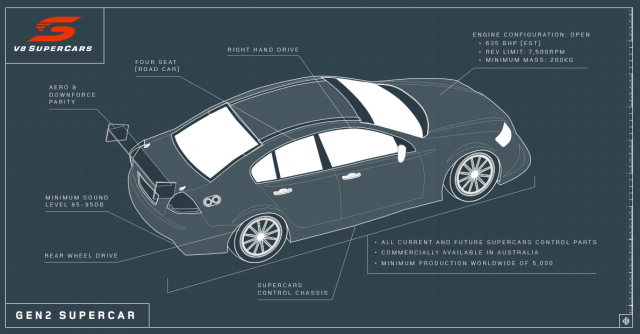

V8 Supercars is confident that the recent release of its Gen2 homologation guidelines has given manufacturers the information they need to begin formulating their 2017 plans.
Devised under the management of V8 Supercars technical director David Stuart, the first draft of the homologation guidelines was sent to teams and manufacturers late last month.
The document outlines the basis parameters for homologating cars under Gen2, which will see two-door coupes and non-V8 engines welcomed into the championship.
As outlined at the launch of the Gen2 concept last year, the race cars must continue to use the current control chassis, be rear-wheel drive and feature the bulk of the existing control components.
Any participating model must have a minimum production volume of 5,000 cars of the same body shape worldwide, be factory imported into the Australian market and have four seats in its road going form.
The current engine and aero parity levels will meanwhile be maintained, ensuring teams can continue to run their current packages competitively.
Although admitting there is still significant work to do before final regulations are delivered, Stuart says there is “absolutely no reason” why manufacturers can’t kick-off their planning.
“What we want to encourage is manufacturers to read the guidelines and, through their homologation team, actively work with us,” Stuart told Speedcafe.com.
“That way a manufacturer isn’t going to head off in a direction that may or may not fit the ultimate rule book.”
While manufacturers will be able to present other engine configurations for consideration, V8 Supercars has focussed on developing its regulations to achieve parity between V6 turbos and the current 5.0 litre V8s.
The new engines will be subject to the same performance parity requirements as the current units, which stipulates a maximum cumulative power figure between 5,800rpm and 7,450rpm.
Stuart confirmed that V8 Supercars plans to undertake a track testing program with its own twin-turbo V6 engine, which is based off a naturally aspirated Holden motor.
“We’ve done a lot of theoretical background work on different configurations and will use the V6 turbo as our development test bench,” he said.
“Once we have it up and running we’ll be doing all our engine management software and control with it to test our ideas on how we balance out the power.
“We’ll then drop it into one of our prototype chassis, which we’ve already done the planning for, and embark on track testing, probably in the third quarter of this year.”
Stuart is confident that the originally stated concept that manufacturers will be able to ‘drop in’ existing engines from their global programs with minimal local development will be met.
Existing manufacturers Nissan, Ford and General Motors all have V6 turbos competing in either GT3 or United SportsCar competition that theoretically fit the bill.
The current Car of the Future engine regulations were heavily criticised for requiring 5.0 litre V8s that, given the constraints, had to be developed at high cost specifically for V8 Supercars.
“There will be packaging constraints that they’ll have to deal with, but it (the concept of utilising existing engines from other categories) is not that far away at all,” said Stuart.
“If that’s what a manufacturer wants to do, they’ll present it, we’ll run it on dyno and find if it fits within the (performance) boundary.
“Once it goes through that, we’ll strip it and create an Engine Specification Document that homologates the engine, like what we have now.”
V8 Supercars marketing director John Casey says the category will give teams and manufacturers time to ‘digest’ the guidelines before going into ‘consultation mode’ with the aim of having final rules by the end of the year.
“Q4 (the fourth quarter of the year) is the aim,” Casey told Speedcafe.com.
“We’ve got to give enough time for teams and manufacturers can execute against the rules in time for 2017.”



















Discussion about this post